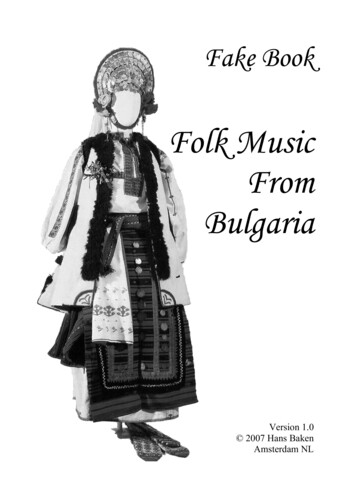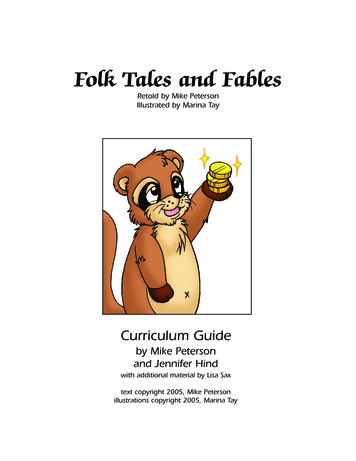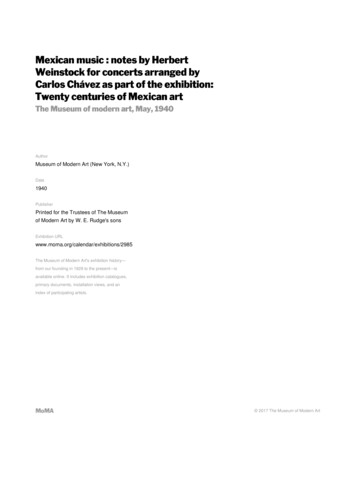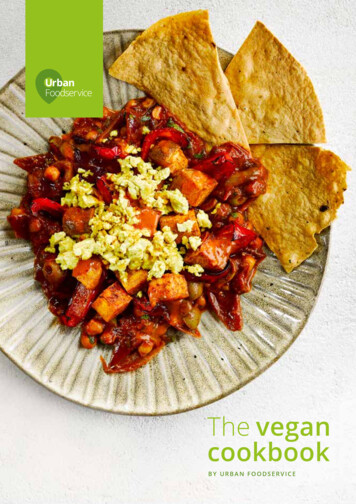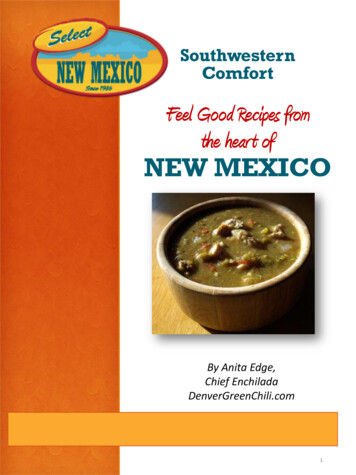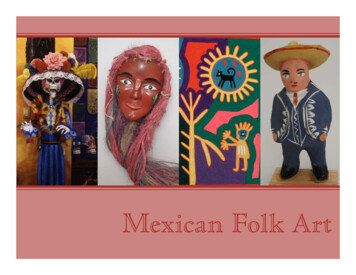
Transcription
Mexican Folk Art
Mexican Folk ArtWritten and Designed by Nicole MullenBased in part by the exhibition Tesoros Escondidos: Hidden Treasures from the MexicanCollections curated by Ira Jacknis, Research Anthropologist, Phoebe A. Hearst Museum ofAnthropology.Object Photography: Therese BabineauIntern assistance: Elizabeth LeschCopyright 2004. Phoebe A. Hearst Museum of Anthropology and the Regents of the University of California.All rights reserved.This publication was made possible in part by a generous grant from the William Randolph Hearst Foundation.
PHOEBE A. HEARST MUSEUM OF ANTHROPOLOGYTABLE OF CONTENTSMexico4Map5Ancient Mexico6The Spanish Conquest8The Mexican Revolution and Renaissance10Folk Art11Masks13Pottery17Laquerware21Clothing and Textiles24Baskets, Gourds and Glass28Toys and Miniatures30Paper Arts33Tin and Copper35Art of the Huichol36Oaxacan Woodcarving38Fireworks39Food40Day of the Dead43Vocabulary47Review Questions48Bibliography503 MEXICAN FOLK ARTFemale figurine. Made by Teodora Blanco;Santa María Atzompa, Oaxaca. TeodoraBlanco (1928-80) was a major Mexican folkartist. While in her late twenties she beganto make her female figurines, for which sheis best known. This pot-carrying figure wearsa Oaxacan shawl around her head.
PHOEBE A. HEARST MUSEUM OF ANTHROPOLOGYMexico Mexico is very diverse geographically. It is made up of fertilevalleys, tropical forests, high mountain peaks, deep canyons,and desert landscapes.Clockwise: Pacific coast, south of Puerto Vallarta, Jalisco, 1996.Lake Pátzcuaro, as seen from Tzintzuntzan, Michoacán, 1996.Landscape at Hacienda Venta de Cruz, Hidalgo,1995.Landscape near the Acueducto del Padre Tembleque, México, 1995.Photographs by Stanley Brandes, Professor of Anthropology, UC Berkeley.4 MEXICAN FOLK ART
PHOEBE A. HEARST MUSEUM OF ANTHROPOLOGY5 MEXICAN FOLK ART
PHOEBE A. HEARST MUSEUM OF ANTHROPOLOGYAncient Mexico Mexico hasa long andrich history.Around 1500 BCgreat civilizationsbegan to form.For over threethousand years,until the SpanishConquest in1521, the Olmec,Maya, Teotihuacán, Toltec, and Aztec ruled over the lands and peoplesof what is now Mexico.These groups lived in regions stretching from the Rio Grande borderlands in the north to Guatemala in the south. They raised crops suchas corn, beans, squash, tomatoes, cacao, chili peppers, and cotton.Ancient peoples traded with surrounding areas for jade, obsidian, andmetals. Important technologies were pottery, weaving, and stoneworking. As early as the 6th century BC, the people of this region created and used a 260-day ritual calendar. Around AD 150 the Maya developed an advanced form of hieroglyphic writing.Male figure, from Colima or Jalisco; Late Formative Period (200BC—AD500).Ruins, West Building, Quadrangle of the Nuns, Maya archaeological site; Uxmal,Yucatán. Photograph by Stanley Brandes, Professor of Anthropology, UC Berkeley.6 MEXICAN FOLK ART
PHOEBE A. HEARST MUSEUM OF ANTHROPOLOGYClockwise: Female figure. Nayarit; Late Formative Period(200 BC-AD 500). Male and female figures were placed inNayarit tombs.Bowl and effigy jar. Casas Grandes culture, Chihuahua;Ramos Polychrome style (ca. AD 1300-1400). The CasasGrandes Culture developed between AD 1150 and 1450 alongthe river valleys of northern Mexico, extending northward intosouthern Arizona and New Mexico. The cultural center wasthe town of Paquimé, also known as Casas Grandes, locatedalong the Rio Casas Grandes. This was a border region,between the great Mesoamerican civilizations and theMogollon and Hohokam populations of the AmericanSouthwest. The effigy figure may be a cat; its use is unknown.Spindle whorl. Chalco, State of Mexico (shown larger thanactual size, which is about that of a quarter). Small discs ofclay, wood, or gourd are used with a spindle rod in order tospin fibers by hand. Spindle whorls come in a great variety offorms and decorations.7 MEXICAN FOLK ART
PHOEBE A. HEARST MUSEUM OF ANTHROPOLOGYThe Spanish Conquest In 1519 the Spaniard Hernando Cortes sailed to Mexico with hisarmy seeking gold and other riches. Cortes defeated Moctezuma,the king of the great Aztec empire, and for the next 300 hundred yearsMexico was ruled by Spain. Over time, marriage between the Spanishand native populations created a new ethnic group called mestizo.The Spanish influenced much of the culture in Mexico. During thistime, horses were introduced. Many other European technologies werebrought to Mexico. The Spanish also introduced the Catholic religionto the Native populations.Mexico fought for its independence from Spain and won in 1821.About 60 Indian groups still live in Mexico today, more than fourhundred and fifty years after the Spanish conquest.Religious lithograph of El Santo Niño de Atocha. Mayo Indians; Navojoa District, Sonora.Lithography is a type of printing process that was invented in Germany in 1798. When the Spanishintroduced Christianity to Mexico religious prints like this one, called estampas became common.This image is of a Christian saint called El Santo Niño de Atocha.8 MEXICAN FOLK ART
PHOEBE A. HEARST MUSEUM OF ANTHROPOLOGYMilagros on display inMexico City church,1996.The word milagro means“miracle” in Spanish. Theyare miniature objects insilver, tin, or gold. First, aperson will ask for a favorfrom a saint. Once thefavor has been granted amilagro is pinned on ornear a religious figure inthanks for the granting ofa favor. A heart may beused to represent theworries of a heart condition or to represent thelove someone might feelfor another person, an eyeis chosen for sight, an earfor hearing. The use ofsuch images was introduced by the Spanish.Milagors were once handmade; however today theyare often sold by streetvendors or in shops. Theyare often strung up on redribbons.Photograph by StanleyBrandes, Professor ofAnthropology, UC Berkeley.9 MEXICAN FOLK ART
PHOEBE A. HEARST MUSEUM OF ANTHROPOLOGYThe Mexican Revolution& Renaissance The Mexican revolution took place in 1910, almost onehundred years after Mexico won its independence fromSpain. The revolution occurred because of a serious conflictbetween rich and poor. The goal of the revolution was tooverthrow the dictator Porfirio Díaz. Under his rule, a smallgroup of people controlled most of the country's power andwealth, while the majority of the population worked in poverty. The revolution was fought and won by Mexican peasants.The 1920s and 1930s have often been described as Mexico'srenaissance. During this time the government and the generalpopulation took a new interest in the arts and culture ofMexico. Many people began collecting and preserving folkarts in Mexico and exhibitions on Mexican folk arts were displayed in museums in Mexico and in the United States.A Mexican print representing a soldier fighting for the rights of peasants during the revolution.Image courtesy of Dover Publications, Inc.10 MEXICAN FOLK ART
PHOEBE A. HEARST MUSEUM OF ANTHROPOLOGYFolk Art Folk art is not an easy word to define. Some folk art is made forsale to collectors. Other things considered folk art by some aremade to be used everyday, such as hand-made children's toys. Somefolk art in Mexico has been influenced by the Spanish while other folkart is based on traditional Indian arts and craft. Today, about 8 percentof the Mexican population, many of them Indian, earns a living makingand selling forms of folk art and craft. Folk arts often begin with thecreative ideas of a single person or a family and are then taken up byothers in the village. Although folk art is based on shared traditions, itis constantly changing and evolving into new forms. Many, but not alltypes of Mexican folk art and craftare covered in these pages.Model ox-cart sculpture. Mixtec Indians; Arrazola or San Martín Tilcajete,Oaxaca. The ox cart is a common sight in rural Mexico. This is an early form ofOaxacan wood carving made for sale. The craft started by the 1940s with dolls. Bythe 1960s, an artist named Manuel Jiménez had made the carvings quite popular.By the 1980s there was an explosion in brightly painted copal wood carvings fromOaxaca.Vendor figurines. Tlaquepaque, Jalisco. These are mold-made, hand-painted claysculptures representing common market vendors. Since the 1930s, the Pandurofamily has specialized in the craft, using the same molds for generations.11 MEXICAN FOLK ART
PHOEBE A. HEARST MUSEUM OF ANTHROPOLOGYSet of wake (velorio) figures. Made by Timoteo Aguilar; Ocotlán de Morelos,Oaxaca. This set of 19 hand-painted ceramic figures shows a wake scene, animportant ritual of traditional Mexican culture. These figures were made for sale totourists, and became popular in the 1950s. This style was created by Doña IsauraAlcántara Díaz. She taught the style to her five daughters, along with their husbandsand three brothers.Since ancient times people in different areas of the world have participated inwakes. Wakes usually take place the night before a burial. The wake allows friendsand relatives of the deceased to come to terms with the passing of a loved one.Often, traditional songs and prayers are recited and food and drink are offered at thewake. Wakes may vary from part of one night to three nights in length.12 MEXICAN FOLK ART
PHOEBE A. HEARST MUSEUM OF ANTHROPOLOGYMasks Masks have been used in manycultures around the world. Maskswere an important part of Mexicanculture long before the Spanish arrived.Today, masks are mostly found in thesouthern, central, and northwestern statesof Mexico where many Indian populationslive. Masks are still used at many festivalsand ceremonial dances. Many of themasked dances are performed to securehappiness and good fortune. Popularsubjects performed with masks includereenactment of the Spanish Conquest,religious tales, and dramas that includeanimals and supernatural figures.In most areas masks are made by specialists who are usually men.Sometimes dancers make their own masks. Carved and painted woodis the most common material used. Masks are also made from leather,papier-mâché, clay, cloth, cardboard, wire mesh, gourds, and wax.Malinche mask. (Left) Nahua Indians; Guerrero. This mask played a key role in the Tenochtli Dance,which tells the story of the fall of Tenochtitlán, the Aztec capital.Hermit mask. (Right) Tarascan (or Purépecha) Indians; Michoacán. This mask is used in the PastorelaDance, a play for the Christmas season. Most of the dancers, unmasked, are girls and women. Menare the characters in the play who wear the masks.13 MEXICAN FOLK ART
PHOEBE A. HEARST MUSEUM OF ANTHROPOLOGYClockwise: Helmet mask. Tlapanec Indians; area of Axoxuca,Guerrero. This eye-catching mask is made of two thick piecesof leather that have been sewn together, with a large nose andhorns of wood, and ribbon decorations. It may have been usedin the Dance of the Vaqueros (cowboys), which centers on thecapture of a bull. Its ears are devil-like, but the horns are morelike a scorpion or insect.Grasshopper mask, with a human face (shown from 2 sides).Made by Ernesto Abrajam, Nahua Indian; Tixtla, Guerrero.Giant's mask. Zoque Indians, Rayón, Chiapas. Made by FelizLópez, ca. 1945. This is one of up to three giant's masks thatare used in the Dance of the Giants (Baile de Gigante). Heldduring carnival time, this dance tells the story of David andGoliath. Goliath, who carries a wooden machete,repeatedly charges the audience and frightens the children. Onthe top of their heads, above their masks, the giant dancerswear the skins of rams with the horns attached.14 MEXICAN FOLK ART
PHOEBE A. HEARST MUSEUM OF ANTHROPOLOGYThese ritual masked figurescalled chinelos are typical ofCarnival and other ritualoccasions throughout the stateof Morelos.Photograph by Stanley Brandes,Professor of Anthropology, UCBerkeley.15 MEXICAN FOLK ART
PHOEBE A. HEARST MUSEUM OF ANTHROPOLOGYClockwise: Masked dancer.Corpus Christi "negrito" clown; Tzintzuntzan, Michoacán, 1996.Corpus Christi clown; Tzintzuntzan, Michoacán, 1996.Chorpus Christi is a religious holiday in Mexico that takes place between the end of May and the15th of June.Photographs by Stanley Brandes, Professor of Anthropology, UC Berkeley.16 MEXICAN FOLK ART
PHOEBE A. HEARST MUSEUM OF ANTHROPOLOGYPottery Pottery is probably the most popular Mexican folk art, and one ofthe most ancient. Pottery is found throughout the country, inmany different styles and forms. Mexican pottery was traditionallymade by hand, using coils or molds. Called earthenware, this clay wasfired at low temperatures. Before the Spanish came to Mexico, thefiring took place in bonfires. Mineral glazes, the potter's wheel andopen top kilns were introduced by the Spanish and are sometimes usedtoday.Common everyday pottery (la loza corriente) is simply decorated. Itcomes in a range of shapes and sizes. Most of this pottery is used tohold food or liquids. The more decorative pottery is often used forceremonies or household decoration. Pots are decorated with slips(layers of liquid clay), paints, and glazes. Animal and human figurinesare often made for sale.Villages often specialize in making certain types of pottery. In manyareas of the country, women might make the common ware and menthe decorative. In some villages the entire family will work together tomake a certain type of pottery.Tree of Life (candelabra). The tree of life is a popular form of art in Mexico.Shaped in the form of a tree, it is then crafted in great detail with figures suchas people, branches, flowers, fruit, animals and other subject matter. Trees of lifeusually hold candles and are often placed as decorative objects at weddings,churches, funerals, and various special occasions.17 MEXICAN FOLK ARTPottery, like all other Mexican crafts, has changed in the last 100 years.Traditional pottery is still made, but now usually for sale.
PHOEBE A. HEARST MUSEUM OF ANTHROPOLOGYClockwise: Water jar. San Bartolo Coyotepec, Oaxaca. Since the 1950s, the villagehas been noted for this unique blackware. Blackware is made by what is called areducing atmosphere. When oxygen is prevented from reaching the pots during thefiring, the clay combines with the carbon dioxide in the air which creates ablack surface. The design is made by polishing some areas with a stonebefore a firing.Water jar in the form of a duck. Tonalá, Jalisco; ca. 1880-1915. Tonalápottery was traditionally popular for water jars because the clay that wasused had a nice fragrance. The back on this duck has a hole for filling itwith water and its beak has a hole for pouring the water.Bank in the form of a human head. Tonalá, Jalisco. Though originallymade for children, ceramic banks are greatly enjoyed by adults. The headform was first used in Tonalá during the 17th century and later made intobanks. Banks like the one pictured here are now rare.Water jar. Yucatán. Although an example of common every day pottery, this jar isquite pretty.Pitcher. Ixtaltepec, Oaxaca.18 MEXICAN FOLK ART
PHOEBE A. HEARST MUSEUM OF ANTHROPOLOGYClockwise: Andrea Cuiriz, potter in the town of Tzintzuntzan, Michoacán. She isfitting together two halves of an olla, using pottery molds typical of the region,1967.Pátzcuaro pottery market, state of Michoacán, 1967.Common and decorative pottery for sale at the market.Photographs by Stanley Brandes, Professor of Anthropology, UC Berkeley.19 MEXICAN FOLK ART
PHOEBE A. HEARST MUSEUM OF ANTHROPOLOGYDon Trinidad Rendónloading his adobe kilnwith ollas; Tzintzuntzan,Michoacán, 1968.Photograph by StanleyBrandes, Professor ofAnthropology, UCBerkeley.20 MEXICAN FOLK ART
PHOEBE A. HEARST MUSEUM OF ANTHROPOLOGYLaquerware Lacquer is a shiny coatingapplied over wood or gourdfor protection or decoration.Applying lacquer is not an easything to do. First, the surface issmeared with vegetable or insectoils. Next, it is covered with severalcoats of powdered minerals, whichare dried and polished before beingpainted.Lacquer is done in three regions—Michoacán, Guerrero and Chiapas.Three basic methods are used to create lacquerware: inlaid (embutido)is popular in Michoacán; painted (aplicado or dorado) in Guerrero andChiapas; or carved (rayado) in Guerrero.Small box on stand, with key. Made by Juan García-Castro, Olinalá, Guerrero, ca.1960. Painted lacquered boxes, in different sizes, have been popular in Mexicosince Colonial times. This small box was made from the sweet-smelling but nowrare linaloe wood. The artist of this piece, regarded as one of the best painters inOlinalá at the time, was a part-time barber.Tray (detail). Rayado technique. Olinalá, Guerrero. Rayado-style lacquer ware ismade by groups of artists who specialize in this type of the craft. Women usuallybuild up the lacquer layers, while male artists usually carve out the designs. Thedesign is worked out with a thorn, and the piece is then returned to the womenwho add on more pigment and polish the surface. Then the design is cut throughto show the underlying colors, followed by more powder and polishing.21 MEXICAN FOLK ARTFor inlaid pieces, a design is first laid down. Next, parts of thepattern are cut out and the hollows filled in with another color. For thecarved technique, two coats of contrasting colors are applied and thetop coat is scratched away. For painting, designs are simply paintedwith oil pigments onto the lacquer surface.Laquerware often comes in the form of gourds, as well as woodentrays, dishes, and boxes. Decorations include flowers, leaves, people,birds, and other animals.
PHOEBE A. HEARST MUSEUM OF ANTHROPOLOGYClockwise: Tray. Made by Doña Cuca Cerda, Pátzcuaro, Michoacán. This inlaid tray wasmade with the fat of the aje insect. The insect is boiled, ground, filtered, and dried toextract the fat, which is then often mixed with the oil of chia seeds.Snake figurine. Made by Ernesto Jiménez, Olinalá, Guerrero. Appropriately–shapedgourds are often formed into animals as decorative objects. This unusual snake wascleverly made from a twisted root.Gourd bowl. Olinalá, Guerrero. Lacquer ware is especially popular in the Guerrero townof Olinalá. The material used for the lacquer is the oil from chia seeds.22 MEXICAN FOLK ART
PHOEBE A. HEARST MUSEUM OF ANTHROPOLOGYLeft to right: Preparation of a batea; smoothing the outsidewith a hand scraper.Preparing pigments; Michoacán technique.Finishing touches being made to a piece of laquerware.Photographs by Katharine Jenkins.23 MEXICAN FOLK ART
PHOEBE A. HEARST MUSEUM OF ANTHROPOLOGYClothing and Textiles Mexican clothing is rich in tradition,combining Indian and Spanish elements.Weaving is an ancient Mexican craft. The oldestloom-woven fragment in the country dates backto between 900 and 200 BC. Fibers used include:bark, agave, and cotton. The Spanish introducedwool and silk. Later on, man-made fibers anddyes came into use. Before the Spanish came toMexico, fabrics were woven on the backstraploom. This is still used by Indian women todayto weave narrow panels of cloth. Men weave onthe treadle or floor loom (introduced by theSpanish), creating wider pieces of cloth.As in all cultures, Mexican clothing comes in many varieties. It is oftenset apart by gender (female, male), by class (rich, poor), and by occasion (everyday, ceremonial).Child wearing a quechquémitl; San Pablo Toliman, Querétaro.Photograph by Katharine Jenkins.Legging Ornament. Mexico; 19th century. Shortly after the Conquest the Spanishforbade the Mexicans to ride horses, but riding slowly spread, especially on ranches. By the 19th century, horseback riding became a national sport for the upperclass. Riders wore beautiful costumes, made with silver and silk embroidery.24 MEXICAN FOLK ARTIn Mexico, especially among Indian groups, in addition to a skirt,women wear one of two common forms of blouses: a sleeveless tunic(huipil) and a closed shoulder-cape (quechquémitl). Today, manywomen are wearing sleeved blouses, introduced by the Spanish. Men'sclothing has changed more. The shirts and pants they wear are bothEuropean fashions. Around their shoulders women sometimes wearrectangular shawls (rebozo). In the 19th century men often wore largeblanket capes (sarape).
PHOEBE A. HEARST MUSEUM OF ANTHROPOLOGYLeft to right: Saltillo-style sarape (detail). Northern and central Mexico; ca. 1830-80. Saltillo sarapes are perhaps the finest and most beautifulLatin American textiles of their period. Although the origins and exact history of the Saltillo sarape are unknown, they are probably a mix ofindigenous and Hispanic elements. They seem to have developed during the 19th century, with their greatest popularity between about 1830 and1880. Sarapes seem to have started from clothing of Indian men. The Saltillo was made popular by vaqueros (cowboys) and other mestizo peopleof the countryside, before being taken up by wealthy landowners in northern and central Mexico. Just as satillo sarapes were beginning to losepopularity in the late 19th century, the sarape had become a Mexican national symbol, spreading to all classes.Huichol Indian Costume. Santa Catarina, Jalisco. Among the Huichol, men's costumes tend to be more decorated than women's, unlike mostMexican indigenous groups. This is ceremonial wear. The designs, embroidered with yarn on cotton cloth, represent spiritual symbols of birds,eagles, and the star-like toto flower.Woman's blouse. Nahua Indians; Southern Huasteca of Hidalgo and Veracruz. In most of Mexico, sleeved blouses have gradually replaced huipilsand quechquémitls.25 MEXICAN FOLK ART
PHOEBE A. HEARST MUSEUM OF ANTHROPOLOGYWoman weaving on a backstrap loom; Navenchuac, Zinacantecos, Mexico, 1952.Sarape weaver.Photographs by Katharine Jenkins.26 MEXICAN FOLK ART
PHOEBE A. HEARST MUSEUM OF ANTHROPOLOGYNahua Indian women wearing traditional huipils; Amatlan, Veracruz, 1957.Photograps by Katharine Jenkins.27 MEXICAN FOLK ARTMan weaving braid for hat; Nevachauc, Chiapas, Mexico, 1952.
PHOEBE A. HEARST MUSEUM OF ANTHROPOLOGYBaskets, Gourds and Glass Basketry is one of the mostancient of Mexican crafts. Likepottery, basketry may be created foreveryday use or for decoration.Gourd containers are another commoncraft. Used as early as 8000 BC, thegourd is a natural container. Many areleft plain as bowls and utensils, someare used for rattles, while others aredecorated for sale. In parts of Oaxaca,gourds are decoratively carved by Mixtec Indians. Coconut shells andother large seeds are carved in the same way in Tabasco and Veracruz.Glass was introduced to Mexico by the Spanish. Puebla was the firstplace glass was crafted, from which it spread to Mexico City andJalisco, where most Mexican glass is made today. While glass is mostcommon in the form of containers, it is also popular in bead form forjewelry. Mexican hand-blown glass is noted for its rich variety of color.Bottle. Glass, swirled, amber glass, Central Mexico.28 MEXICAN FOLK ARTCarved gourd bowl (detail). Central or southern Mexico; ca. 1910. Gourd bowls are often made fromthe rind of the fruit of the calabash tree (Crescentia cujete), grown in the coastal areas of Guerreroand Oaxaca. The carved design on this one depicts birds, trees, and circular medallions, one of whichbears the inscription "Republica Mexicana," over the national emblem of an eagle holding a snake.This image was probably taken from a coin, as this ancient Aztec symbol has appeared on the backof all Mexican coins since 1823.
PHOEBE A. HEARST MUSEUM OF ANTHROPOLOGYClockwise: Basket. Tarahumara Indians; Creel, Chihuahua.This basket—double-woven in two layers, was made for saleto tourists. Among the Tarahumara, women are the basketweavers.Carved coconut. Veracruz or Tabasco.Water bottle, gourd. Mayo Indians; Navojoa District,Sonora. In addition to decorative objects made for sale,gourds in Mexico are often used for everyday purposes.Bottle. Mexico, region unknown.Basket with lid. Mixteca Baja Indians; Oaxaca.29 MEXICAN FOLK ART
PHOEBE A. HEARST MUSEUM OF ANTHROPOLOGYToys and Miniatures Toys are an exciting and fun part of Mexican folk art. They aremade from all kinds of materials. There are many different typesof folk toys. Dolls or other kinds of human and animal figurines arepopular along with coin banks, pull or push toys, whistles and rattles.In addition to the common, everyday toys, many are made forceremonial use,especially for Day ofthe Dead. Many toys,once made for a child'splay, have now becomeforms of folk art that are made for sale.Miniatures are an especially rich tradition inMexico. They are made to look just like the full-size objects they aremodeled after. They may be made by children or used as children'stoys, made and collected by adult Mexicans, or sold to foreign tourists.Male figurine. Mexico Federal District. Many miniature male figurines of papier mâché resemblesimilar figures once made for Easter. The larger versions served as supports for fire-works or wereset up in front of shops. They were crafted into many forms, such as devils, animals, bandits ordisliked politicians. Most small paper mâché figures, such this a small toy, are made with molds.Noisemaker, bird-form (matraca). Mexico Federal District. These noisemakers were used duringHoly Week (the week before Easter), a time when church bells were not allowed to be rung. Given asEaster gifts, they were used by children.30 MEXICAN FOLK ART
PHOEBE A. HEARST MUSEUM OF ANTHROPOLOGYClockwise: Model airplane. Mexico, unspecified. A universalchildren's toy, this one is made of palm leaf.Wheeled whistle. Mexico Federal District. This tin whistle hasa pinwheel above the opening, which whirls when the whistleis blown.Push toy. Oaxaca.Pecking bird toy. Toluca, State of Mexico. When the string ispulled through the hole, the bird bends down to eat from the acorncup. A weight, now missing, was usually attached to the thread.31 MEXICAN FOLK ART
PHOEBE A. HEARST MUSEUM OF ANTHROPOLOGYClockwise: Male and female figurines. Jalisco, Puebla, orMexico Federal District. Corn is the staple food in Mexico, soits husks are abundant throughout the country. This couple iscarrying their goods to sell at a market.Ram figurine. Amozac, Puebla. Ram figurines were mostcommonly mold-made in the form of banks. Versions made ofsugar paste were used especially to decorate Day of the Deadaltars, but are now rare.Male figurine. Painted clay, Oaxaca.Dressed fleas. Guanajuato. Practiced in Mexico for well overa century, the art of dressing fleas in tiny costumes has nowdisappeared. This pair is dressed in tiny male and female costumes; other examples are grouped into scenes like weddings.32 MEXICAN FOLK ART
PHOEBE A. HEARST MUSEUM OF ANTHROPOLOGYPaper Arts Paper has been used in Mexico since ancient times. Paper createdfrom tree bark was made into books to record ancient histories.It was also used for decoration and for ceremonial use. The OtomiIndians still prepare bark paper by hand. The paper is most often usedto make paper dolls that represent different humans, animals andspirits. These paper dolls are used in different rituals.made by the Otomí Indians is also used by Mexican artists,especially from the state of Guerrero. On this bark paper, they createlively paintings that include flowers and animal figures.BARK PAPER(papel picado) are a popular form of decoration used forholidays and festivals in Mexico. In its simplest form, tissue paper isfolded and cut with scissors to form different patterns. The paper isthen glued together to form banners that can be hung most anywhere.Skilled craftsmen use tools such as blades, awls, and chisels to createmore complicated designs that include animals, skeletons, flowers andmuch more. These craftsmen often cut through fifty or more sheets oftissue paper at one time.PAPERCUTS(papel pegado) is a very popular art form in Mexico.Large carnival head figures and piñatas are made from papier-mâchéfor different festivals and holidays. Animals, skeletons, dolls and othertoys are also made from papier-mâché to be used for decorations or forsale. Pieces of paper are torn into strips and soaked in paste. A frame isPAPIER-MÂCHÉPapier mâché wall masks; Taxco, Guerrero, 1996.Photograph by Stanley Brandes, Professor of Anthropology, UC Berkeley.33 MEXICAN FOLK ART
PHOEBE A. HEARST MUSEUM OF ANTHROPOLOGYmade out of wood or wire to form a body. Strips of paper are then pastedonto the frame. After the piece is dry it is painted. The strips of paper areapplied until the basic shape is created. When the piece is dry, extra features such as noses, ears and hands are added. Next, the piece is decorated with colored papers and foils, or it is painted in bright colors. Papiermâché is also created using molds made from fired clay or plaster. Bycreating molds, the same figure can be made over and over again for sale.Two molds are made, one for each half of the figure. Once the wet paperis almost dry, the two halves are pasted together.Boy making a piñata, covering the rabbit form;Mexico City.Photograph by Katharine Jenkins.Traditional Mexican paper-cut.Ritual doll, bark paper. Otomí Indians; San Pablito,Puebla.34 MEXICAN FOLK ART
PHOEBE A. HEARST MUSEUM OF ANTHROPOLOGYTin & Copper The Spanishintroduced tin toMexico in colonial times.Many items are made fromtin, such as ornaments,mirror frames, and smallboxes. Tin is often cut outby hand, and special toolsare used to punch designsinto the tin. Parts of tin are put together using lead solder and a soldering iron. The tin is then painted in a variety of colors.Copper was also introduced by the Spanish. Craftsmen create copperplates, pitchers, mugs, trays, cups, candlesticks, and other usefulobjects that are sold throughout Mexico. Many Tarascan Indians ofMichoacán specialize in copperware. They hammer out the pieces byhand. Some of these specialists craft miniatures of their larger counterparts.Tinsel flowers. Toluca, Mexico, 1956.Photograph by Katharine Jenkins.Copper miniature, vase, and bowl.35 MEXICAN FOLK ART
PHOEBE A. HEARST MUSEUM OF
Folk Art Folk art is not an easy word to define. Some folk art is made for sale to collectors. Other things considered folk art by some are made to be used everyday, such as hand-made children's toys. Some folk art in Mexico has been influenced by the Spanish while other folk art is based on traditional Indian arts and craft. Today, about 8 percent

